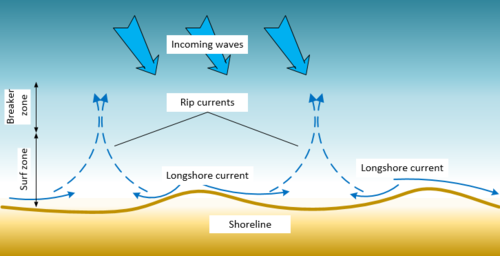| Bfn Currents on foreshore rubble | |
|---|---|
| Context | Bfn Foreshore rubble |
| Type | Condition |
| Decompositie type | IOR |
Nearshore constantly experiences active movements of water masses, that promote transport and exchange of nutrients and sediment, and also the propagation and feeding of organisms living on the shore. These nearshore water currents can be divided based on their origin: tidal currents, wind generated currents and wave generated currents, such as undertow, longshore and rip currents.
Wind driven currents
Wind blowing parallel to the coastline moves water masses away from the shore in approximately 90 degree angle due to the Coriolis effect, transporting the coastal water to the right of the direction of the wind in the Northern Hemisphere and to the left in the Southern Hemisphere. This causes upwelling of colder, nutrient rich waters that are drawn from 100 to more than 200 meter depths to take the place of water displaced by the wind. Upwelling may be seasonal (generally in temperate zones) or occurring mostly all year round in places situated close to the Equator.
Decomposers living at the ocean floor break down detritus from organic material into nutrients, such as nitrogen and phosphorus, and when upwelling brings these nutrients to the coastal zones, it creates large phytoplankton blooms and encourages growth of macroalgae. The large biomass production created by the upwelling provides feed for various coastal organisms and support some of the most important fisheries of the world. On the other hand, the displaced water may flush floating larvae and spawn of coastal organisms, for example, bivalves, crustaceans and fish, far offshore, therefore negatively influencing replenishment of coastal populations (Gaines and Airame, 2012; Miller, 2002; Wong, 2007).
Wave driven currents

In the breaker and surf zones of the shore, wave shoaling and breaking creates a direct forcing of water that flows up the shore, that in turn generates a current flowing in the opposite direction of the shore called undertow. Undertow occurs in the lower parts of the water column between the wave troughs and the coastal bed. This current flows seawards and due to the large crossection area of the discharge, it has a relatively low flow speed from a few cm per second from low waves to several decimeters per second during large storm events.
Longshore currents are generated when the waves hit the shore in an angle, as some of the waves’ momentum carries the water along the shore line in the general direction of the waves’ approach, as illustrated in the image above. These currents flow parallel to the coast in the shallow part of the nearshore. The speed of longshore currents depends on wave height and the angle between the waves and the shoreline, with larger waves and angles producing stronger flows. When longshore currents meet a solid object or flow in an area with a lower water resistance due to lower magnitude waves, they turn seawards creating a rip cell.
Rip currents are strong, but narrow currents that flow offshore with greater speeds than the undertow due to their relatively small discharge area with velocities of approximately 0.5m/s in normal conditions and in some cases exceeding 1m/s. While they can extend more than 1000 meters offshore, rip currents occurring on the open shore are also unstable and tend to migrate on average every 10 minutes (Davidson-Arnott, 2010; Haller, 1990).
De View-Navigation (VN) pagina's.
De links naar andere pagina's.
| Onderdeel van | Bfn Other abiotic factors influencing foreshore rubble |
|---|---|
| Instantie van | |
| Betreft |
Draagt bij aan.
| Draagt bij aan | Bfn Mating grounds and nursery areas of foreshore rubble |
|---|---|
| Waarde | +/- |
| Opmerkingen |
De pagina's die linken naar deze pagina.
Dit element heeft geen subelementen. Naar dit element wordt niet geconnecteerd.






